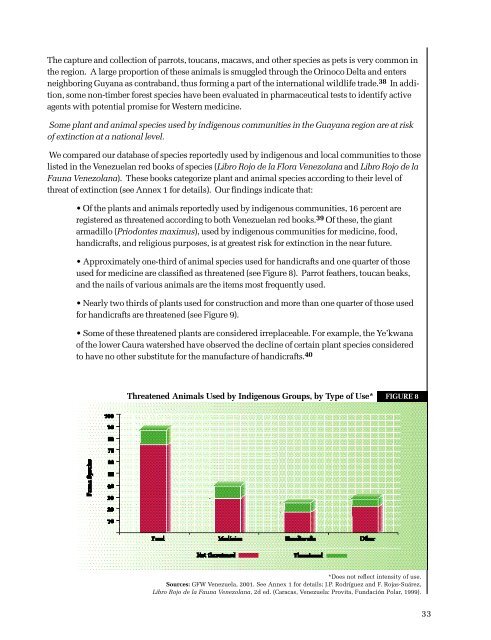Usar pâgs xvii-134 - ResearchGate
Usar pâgs xvii-134 - ResearchGate
Usar pâgs xvii-134 - ResearchGate
You also want an ePaper? Increase the reach of your titles
YUMPU automatically turns print PDFs into web optimized ePapers that Google loves.
The capture and collection of parrots, toucans, macaws, and other species as pets is very common inthe region. A large proportion of these animals is smuggled through the Orinoco Delta and entersneighboring Guyana as contraband, thus forming a part of the international wildlife trade. 38 In addition,some non-timber forest species have been evaluated in pharmaceutical tests to identify activeagents with potential promise for Western medicine.Some plant and animal species used by indigenous communities in the Guayana region are at riskof extinction at a national level.We compared our database of species reportedly used by indigenous and local communities to thoselisted in the Venezuelan red books of species (Libro Rojo de la Flora Venezolana and Libro Rojo de laFauna Venezolana). These books categorize plant and animal species according to their level ofthreat of extinction (see Annex 1 for details). Our findings indicate that:• Of the plants and animals reportedly used by indigenous communities, 16 percent areregistered as threatened according to both Venezuelan red books. 39 Of these, the giantarmadillo (Priodontes maximus), used by indigenous communities for medicine, food,handicrafts, and religious purposes, is at greatest risk for extinction in the near future.• Approximately one-third of animal species used for handicrafts and one quarter of thoseused for medicine are classified as threatened (see Figure 8). Parrot feathers, toucan beaks,and the nails of various animals are the items most frequently used.• Nearly two thirds of plants used for construction and more than one quarter of those usedfor handicrafts are threatened (see Figure 9).• Some of these threatened plants are considered irreplaceable. For example, the Ye’kwanaof the lower Caura watershed have observed the decline of certain plant species consideredto have no other substitute for the manufacture of handicrafts. 40Threatened Animals Used by Indigenous Groups, by Type of Use* FIGURE 8*Does not reflect intensity of use.Sources: GFW Venezuela, 2001. See Annex 1 for details; J.P. Rodríguez and F. Rojas-Suárez,Libro Rojo de la Fauna Venezolana, 2d ed. (Caracas, Venezuela: Provita, Fundación Polar, 1999).33
















